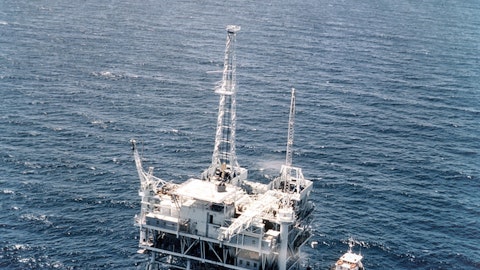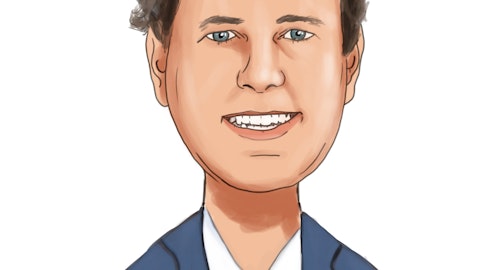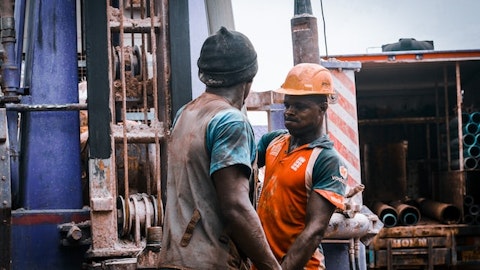Bruno Morand: No, listen, I think we start now with a very strong coverage already in 2024. When I think about the rigs that are — having some white spaces in 2024, the vast majority of that is in the second half where we see a pretty strong demand for our rigs. And we see customers obviously increasing their sense of urgency in securing contracts for these rigs. We see very limited correlation between the dynamics of the deepwater market in the shallow water market. We see our customers still very much committed to securing capacity. I think if I look, for example, anecdotally to the Skald, which is a rig that we extended now in Thailand. Traditionally, PTTEP would have run to a tender process to secure the rig. I think understanding the limited availability of rigs in the market, they decided to directly negotiate without that award, which speaks for the understanding of our customers that we need to secure rigs rather fast before good capacity disappears.
So I think the fundamentals are all very strong. And I see limited risk for us in terms of recontracted and white spaces. Obviously, we mentioned before about our more muted view on the North Sea. So we’re working to find alternative commitments for the P1. At the moment, the rig is contracted into Q1, potentially into Q2, subject to options, I think that’s obviously something we’re working hard towards. But in general, we remain very confident on our ability to maintain rigs utilized for 2024 with very, very limited open space.
Patrick Schorn: Maybe to add to that a little bit, Fredrik. I think that what you see in the deepwater is based on a completely different set of customers than what we see in the shallow water. In the shallow water, we see that the — there is a very big scarcity of modern rigs, and that continues to be there. We see very strategic long-playing customers, and let’s not forget we’re on the short cycle barrel. We can produce much faster from the moment that we start drilling versus any type of a deepwater development. So the barrier to start anything deepwater versus continuing to develop the production in shallow water is very different. And I think that, that is a market that probably going forward will continue to diverge, and I’m very pleased that we are only playing in the jack-up market, so to say.
Operator: And the question comes from the line of Rishad Ahmed from Emso Asset Management.
Rishad Ahmed: Just wanted to ask about the exposure to Pemex. So in terms of the receivables that you’ve got, is this $90.3 million of receivables the full amount of receivables from Pemex? And I mean how much of this has passed due, how has that been — how has that dynamic been playing out? Is this a concern in terms of working capital use and getting paid on time? So I would just appreciate your thoughts on that.
Patrick Schorn: Magnus, could you take this question?
Magnus Vaaler: So we have currently five out of our seven rigs in Mexico is operating through our joint venture and an integrated service provider where the ultimate customer is Pemex. And you are correct, on the balance sheet, our current receivable from the JV is $90 million, which is ultimately Pemex paying. We have, over the past quarters, I say, in years, received consistent payments from Pemex and have received them regularly. There is obviously some buildup in the balance, which is a combination of more activity that we have on the rigs and also that the contract rates for the rigs actually went up from last year into this year. But just all in all, we have received very consistent payments and don’t believe that as a very immediate threat.
We also have, through our JV and through the integrated service provider in the event that there is a payment delay or payment holdup. We also have a close to receive regular payments from the integrated service provider to be sufficient to keep our rigs operating and to cover operating costs so that there’s no funding needed from Borr into the JV to continue to operate the rigs.
Rishad Ahmed: And just in terms of — from an accounting perspective, are these JV results consolidated into yours, so does the EBITDA numbers, for example, include 50% of the JV results? Or how does that work?
Magnus Vaaler: So we bareboat our rigs, the five rigs into the JV. What you will see in our financial statement is the line below the dayrate revenue, the bareboat charges that we do into the JV. So they’re not consolidated, but we are bareboating the rigs on a sort of bareboat rate into the JV.
Operator: And the next question comes from the line of Truls Olsen from Feranley Securities.
Truls Olsen: Well done on the quarter and on the refinancing. I echo Fredrik on that one. Just to couple of questions, Bruno, starting with you. In terms of — on the market, I mean, dayrates continue to move higher. What are you seeing in terms of, call it, improvements on the TNCs? I mean are we seeing any big changes or small changes there? And also adding — what do you see in terms of contract duration moving outside of the Middle East where most of the activity seems to be the case for now, is it changing given the, call it, tightening market dynamics?
Bruno Morand: Listen, for sure, terms and conditions go hand-in-hand with our pricing power. We have been looking at the contract terms that we have with our customers and improving and bringing back to terms that we have closed in 2014 and more until we have more pricing power. That goes into every component of the contract from big in terms to reduce rating contracts, allowances and so on and so forth, markups and so on and so forth. So obviously, that is part of what we’ll be doing with the customer. We expect that to start actually reflecting in the number of dollars dropping to the bottom line positively. Everything is being looked after very carefully. It’s all part of a larger economic view of the contracts. Now in terms of the second part of your questions and duration of contracts, you’re right in saying that when you look at Aramco and a lot of contracting wins in five years and five years plus, that seems to be kind of a strong benchmark for what a long term contract looks like.




